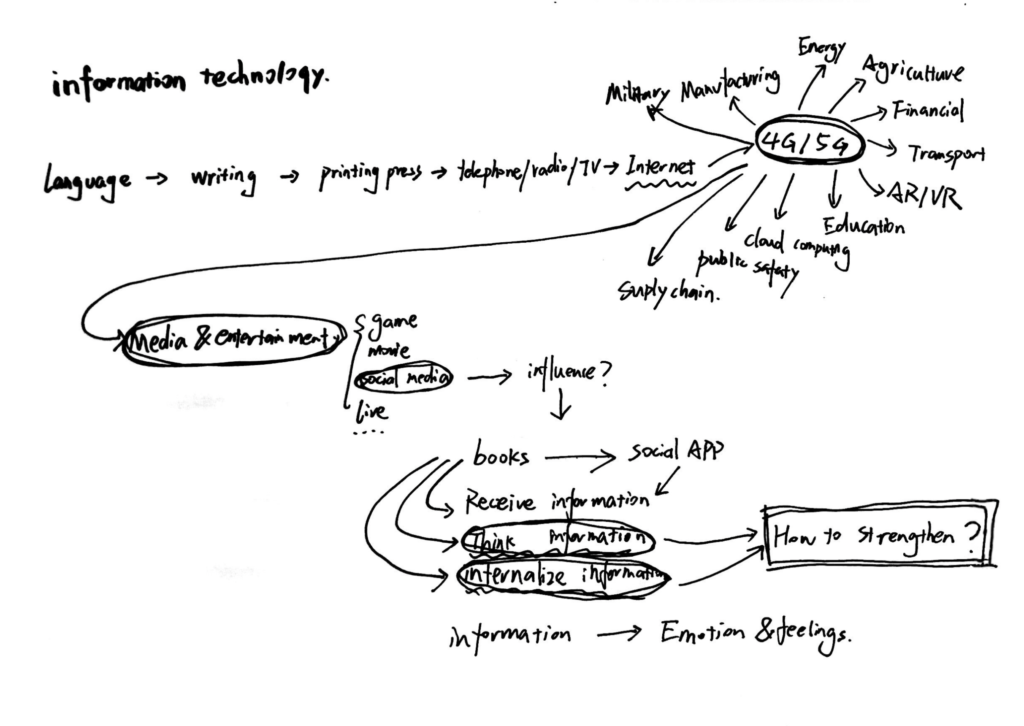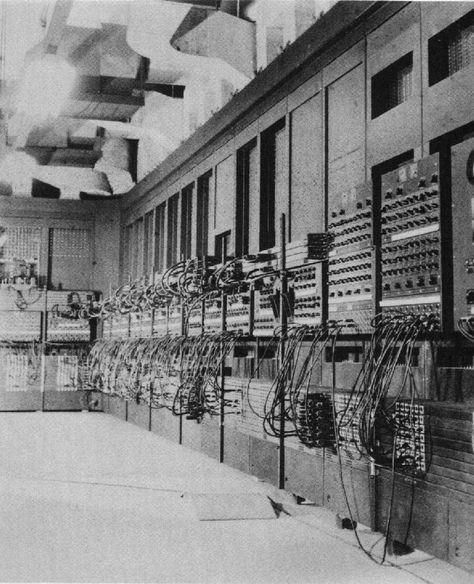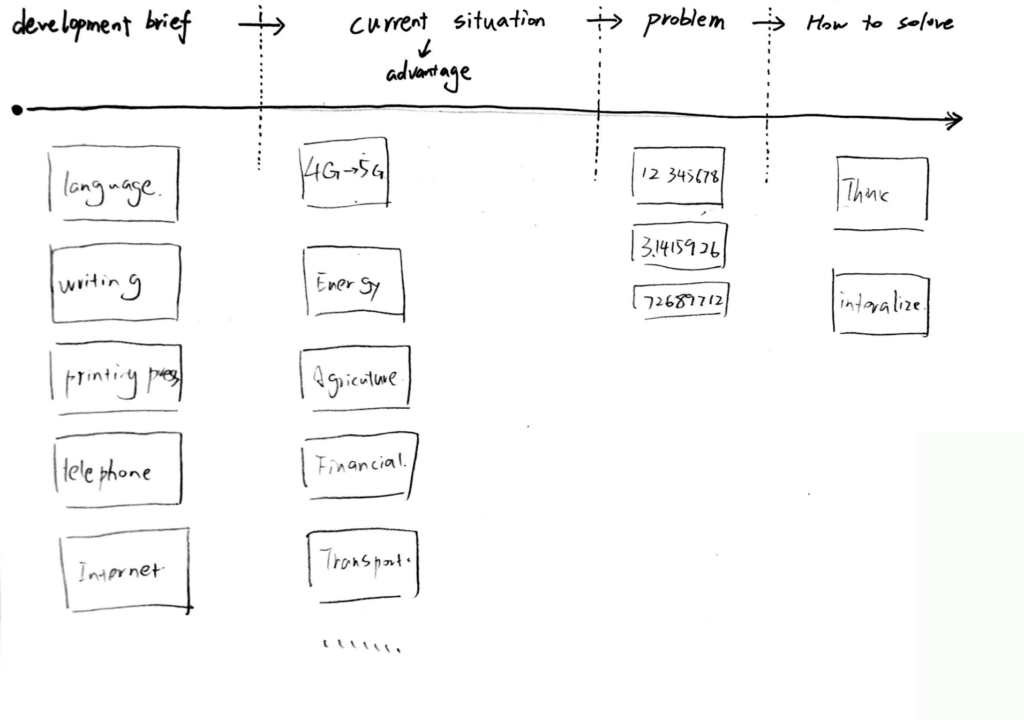Topic selection

I have chosen Convergence as my topic. After my research, I decided that I wanted to try to analyze the development of information technology, what this process is like and how it affects our daily lives.
Research

Five stages in the development of information technology
The first was the use of language, which became an indispensable tool for the exchange of ideas and the dissemination of information.

The second was the emergence and use of writing, which led to a major breakthrough in the preservation and dissemination of information, transcending the limits of time and space.

The third was the invention and use of the printing press, which made books and newspapers an important medium for storing and disseminating information.

The fourth was the use of the telephone, radio and television, which brought mankind into the era of information dissemination using electromagnetic waves.

The fifth was the use of computers and the Internet, i.e. the emergence of the Internet. The application of information technology has enabled human knowledge to be rapidly disseminated, accumulated, analysed, combined, stored and reproduced, thus giving people more means to use, acquire and redevelop knowledge, and thus the growth of knowledge has been extremely rapid in the information age, resulting in a “knowledge explosion”. It is the basis for deepening the reform of education and is a breakthrough and a high point for deepening the reform of education. Modern educational technology and information technology can promote changes in the mode of teaching, changes in the content of teaching, changes in the concept of teaching, changes in the way of learning, changes in the means of testing and changes in practical skills. In short, it is an important factor that influences education and contributes to its development.

The development trend of information technology
1. High speed and large capacity. The speed is getting higher and higher, and the capacity is getting bigger and bigger, both in communication and computer development.
2. Integration. Including business integration as well as network integration.
3. Digitalization. One is to facilitate mass production. In the past, it took a lot of time to produce an analogue device, and each individual part of the analogue circuit needed to be designed and tested separately. The digital equipment is unitary, the design is very simple, easy to mass production, can greatly reduce costs. Secondly, it facilitates synthesis. The physical characteristics of each analogue circuit are very different, whereas digital circuits are made up of binary circuits, which are very easy to synthesise, and often cannot be synthesised in an analogue way to achieve a complex performance. Nowadays, digitalisation is developing very rapidly, and there are many different expressions, such as digital world and digital earth. The main advantage of digitalisation is that it is easy to mass produce and easy to synthesise these two major aspects.
4. Personalisation. That is to say, mobile and global. A person can have the same means of communication anywhere in the world, and can use the same information resources and means of information processing and handling.
The impact of 4G
4G means The fourth generation of mobile phone mobile communication technology standards
4G mobile phones in the 4G era provide audiences with improved functionality for producing and editing multimedia information, and 4G networks give audiences a better experience for uploading and downloading multimedia information.
The 4G network gives audiences a better experience in uploading and downloading multimedia information. Using the advantages of 4G technology to publish authentic information, ensure information security and win the trust of audiences is a sign of the increased power of mobile media.
With the improvement of smartphone internet access and the full coverage of 4G networks, users’ demand for instant communication on smartphones is growing, and the way information is produced, disseminated and received by audiences has changed.
The ideal form of communication from anyone to everyone at any time and any place has been realised, and audiences have formed the habit of rapid browsing and fragmented reading, forming an almost 24-hour accompanying state
5G in future
1. Manufacturing
5G technology can help make manufacturing operations more flexible and efficient, while improving safety and reducing maintenance costs. This will enable manufacturers to use automation, artificial intelligence, AR (Augmented Reality) and the Internet of Things to reach the “smart factory”.
2. Energy and Utilities
5G could bring more innovative solutions to the production, transmission, distribution and use of the existing energy industry, and is expected to develop the next wave of smart grids with greater functionality and efficiency. 5G technology will enable the low-cost connection and integration of many unconnected energy-consuming devices, which will improve grid monitoring and enable more accurate energy demand forecasting, making energy management more efficient, thereby reducing power peaks and overall energy costs.
3. Agriculture
Farmers around the world are using IoT technologies to optimise overall agricultural production processes such as water management, irrigation and fertilisation, livestock safety and farm product monitoring. 5G technologies can facilitate the adoption of IoT devices to achieve this goal.
4. Financial services
5G technology is expected to be used for both one-way and two-way services as financial institutions increasingly focus on the rollout of mobile devices. 5G will enable faster and more secure transactions on mobile phones than any existing process, with vastly improved security and network speeds.
5. Media and entertainment
5G will have a profound impact on media and entertainment on a number of levels, including mobile media and advertising, home networking and television. It will also be critical to improving the experience of new interactive technologies such as AR/VR.
Thanks to 5G’s low latency, films on the network are less likely to pause or stop. On 5G networks, movie downloads will be reduced from an average of seven minutes to just six seconds. When browsing social media, gaming, online media music and downloading movies and shows, 5G will save users an average of 23 hours of loading time per month. In addition, 5G will enable users to interact with virtual characters for future AR/VR applications.
6. Transport business
From buses to taxi fleets, 5G technology can improve the transparency and deployment of transport systems as 5G networks become more prevalent.
Beyond existing transport, 5G can enhance vehicle-to-vehicle (V2V) communications, a key element in improving and responding to the safety of driverless vehicles on the road. V2V communications must be real-time, as a difference of milliseconds can be the difference between an emergency brake and a fatal collision. Achieving this high speed interconnection requires vehicles to transmit large amounts of data between each other without any latency. the low latency of 5G networks enables this to happen.
7. AR/VR
The future of augmented reality (AR) and virtual reality (VR) depends on a wider, more reliable and consistent 5G network. Provided, of course, that the 5G network is mature enough to meet the primary goal of reducing development costs.
AR and VR require the processing of large amounts of data. And 5G’s 10 times less latency, 100 times more traffic and capacity, and 100 times more network efficiency means that 5G can solve these problems.
8. Education
As 5G paves the way for AR/VR experiences, teachers will be able to use these technologies for a variety of new educational techniques. For example, students could go on virtual field trips around the world, from the pyramids of Egypt to the Great Wall of China, without ever leaving the classroom.
AR / VR education platforms offer many benefits over traditional education methods, including cost effectiveness and reduced risk. a study conducted by Next Galaxy Corp and Nicklaus Children’s Hospital found that after receiving VR training, medical staff remembered up to A study conducted by Next Galaxy Corp and Nicklaus Children’s Hospital found that medical staff remembered up to 80 per cent of course material after VR training, compared to 20 per cent for traditional training courses.
9. Cloud computing
Due to the low throughput, high latency and inconsistent connectivity of mobile devices, the functional and characteristic aspects of cloud computing are often downplayed. But 5G networks can increase the impact and flexibility. 5G’s high throughput and low latency will solve existing problems and take cloud computing to the next level.
10. Public safety
5G networks can enhance public safety by reducing the time it takes to receive messages and by making wider use of the network.
Through 5G networks, rescue teams will be able to quickly assist in the first instance through real-time video, secure communications or media sharing, both in terms of time and location, to a much greater extent.
11. Supply chain management
The installation of 5G sensors on equipment can provide a wealth of data in all real time to those involved. This data could include location, temperature, humidity, pressure or other information that is critical to the supply chain.
12. Military
Communications are key to military strategy. Real-time data collection and transmission from communication network devices is critical, and 5G technology can maximise the speed of data transmission.
Enhanced communications networks can minimise noise and latency, which can help prevent casualties in theatre. In addition, 5G technology can also provide a clearer picture of expenditure and resources; the use of more accurate data collection can help with future military budgets.
Fragmented access to information
If one expects to develop the ability to think deeply through reading, one must create the neural circuits in the brain that enable deep thinking through the practice of reading. The establishment of neural circuits in the brain that enable deeper thinking is not a significant advantage of reading in fragments over reading whole books on paper.
Continuing to read in fragments over time, for example, by using electronic tools such as mobile phones to read news and self-published articles, will build up a neural circuit in the brain that is suitable for reading in fragments. As a result of this neural circuitry, a person will subconsciously pick up his or her mobile phone and read news and self-published articles, which will gradually develop into a “hand addiction” and “mind addiction” and may eventually lead to a reduction in reading, boredom and even abandonment of paper. The whole book.
Initial idea/Sketch
